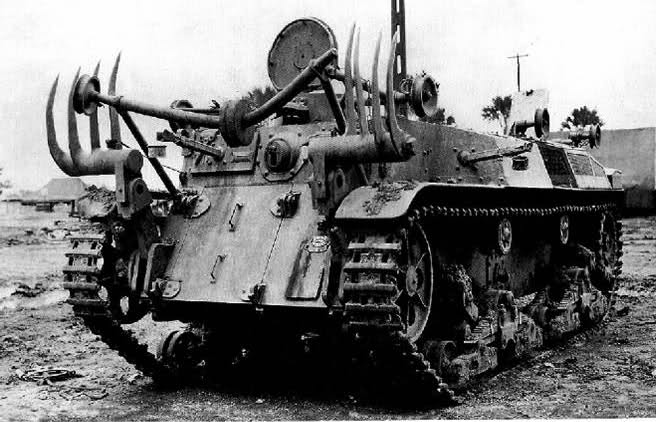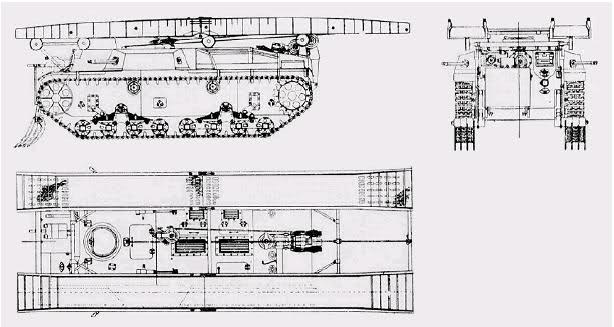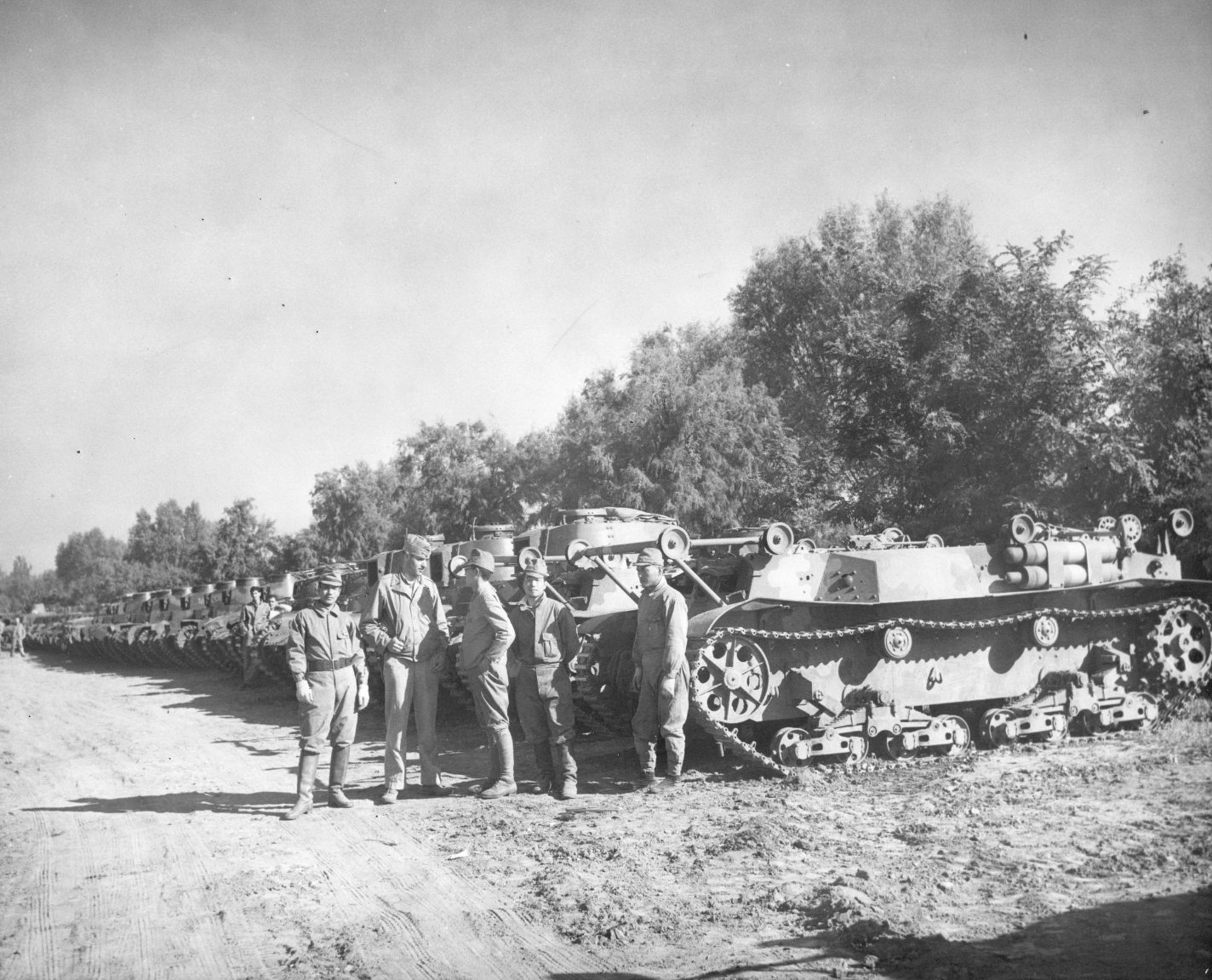Hello everyone,
when you browse various tank forums, you usually run into some threads dealing with the most interesting armored vehicles of WW2. That’s where Soukou Sagyou (SS) usually pops up. Its best known picture is this:
Let’s have a look at it a bit closer.
While preparing for war with the Soviets in the 30′s, the Imperial Japanese Army formulated a demand for the development of a specialized vehicle, capable of destroying Soviet fortified positions along the Manchurian border. And as usual with the Japanese, they decided to actually adopt an unventional solution and to add several useful functions to it. It was decided that this new vehicle should be capable of
- digging trenches
- mineclearing
- cutting through barbed wire
- mass vaccination
- spreading poisonous gas
- being used as a crane vehicle (ARV)
- being used as a flamethrower tank
- beign capable of laying down temporary bridges
That’s a lot of functions for one vehicle and in the end, the tank turned out to be probably the most versatile engineering vehicle in the world.
Many sources state that the vehicle was actually built on the chassis of the Type 89 Yi-Go medium tank, but this is not exactly true. While the design itself did resemble Type 89 and used many of its parts, other parts from other mass-produced vehicles were also used. For example the suspension was somewhat different, although it used two blocks of 4 small roadwheels, it also used only two return rollers and didn’t have that one independent forward bogie. It used semi-eliptical leaf springs. The drive sprocket was located in the rear, while the steering sprocket was in the front.
The first SS vehicles recieved a hull, derived from the (more modern) Type 94, with characteristic tall frontal part and space above the tracks. There were however some changes. The driver’s hatch and the (Type 97 7,7mm) bow machinegun stayed where they were, but the single-wing hatch was replaced by a double-wing one and flamethrowers were installed. The turret was removed as well and instead of it, the commander recieved a small-ish copula with observation devices. Two mineclearing “claws” were installed in the front and there was a winch, powered directly by the engine, installed in the back (capable of pulling even very heavy objects).
Since the vehicle was not supposed to be used as a front line combat tank, it was decided to somewhat reduce the armor thickness. The roof and bottom were 6mm thick, the sides were 13mm thick and the front was 25mm thick. As for the engine, Mitsubishi 145hp (at 1800 RPM) straight 6 (I6) diesel was used, allowing it to go as fast as 37 km/h. The transmission was mechanical. The weight of the vehicle was 13 tons (Russians state 16 tons) and it had a crew of 5.
The first prototype was built and tested in 1931 and it proved to be quite unwieldly. The only role that the vehicle was actually performing really well was the engineering role. Even so, the armament, consisting of 2-3 flamethrowers and one machinegun was quite fearsome (there were apparently variants with two 7,7mm Type 97 machineguns). IJA, after some deliberation, decided to sign a contract for several of these vehicles under the SS Ki designation.
First four SS Ki vehicles were assigned to the 1st Mixed Tank Brigade and they were sent to China. In the Battle of Beijing on 28.7.1937 under Major-General Sakai, these vehicles were used as flamethrower tanks, but they took no part in the following battles and were used only as engineering vehicles. Later, they were sent to the Soviet-Manchurian border as a part of an engineer regiment. In general, the SS tanks were considered to be a successful design and the army became more interested in obtaining more of these vehicles, that would during the war sporadically appear on the Japanese-occupied islands. Within several years (until 1943, included), 119 SS vehicles were built (other sources state 98) in six main variants:
- SS Ki: the main variant
- SS Kou Gata: armored engineering vehicle with modified suspension with four return rollers for each track
- SS Otsu Gata: armored bridgelayer vehicle with modified suspension (new drive sprockets, three return rollers)
- SS Hei Gata: armored trench digger with Otsu Gata suspension and additional armored plates
- SS Tei Gata: armored engineering vehicle with Otsu Gata suspension
- SS Bo Gata: armored bridgelayer with based on SS Ki (last variant)
In December 1941, several dozen of these vehicles were transferred to Philippines (Japanese sources state 20), where they were used as a part of the 2nd Tank Regiment (mostly as bridgelayers) until the end of the war. Unfortunately, there is no more info available on their deployment there. Last mention about them is from Summer 1945, when 8 of them were captured by the Americans during the liberation of Philippines. The American forces classified it (mistakenly) primarily as a flamethrower tank.
http://www.aviarmor.net/tww2/tanks/japan/ss.htm
http://www.forosegundaguerra.com/viewtopic.php?t=6701
http://shushpanzer-ru.livejournal.com/1783374.html




Multitasking ftw
It lacks tentacles
^^lel
clearly not as “multi-tasking” as it could have been
Interesting.
Any info on what happened with the vehicles after the war? Did americans scrapped them and are there any surviving models?
Thanks for this! More info of Japanese tanks are always welcome.
It always interested me since it’s quite different from European (and American) tanks.
I see that you put it in ‘Uncategorized’ maybe you should do a ‘Strange tanks’ or something like this for this kind of tank, I’m pretty sure other nation have also some…weird tanks.
-nvm, i am idiot
Read the article.
Swiss army knife tank.
https://dov5cor25da49.cloudfront.net/products/878/636x460design_01.jpg (related image).
Good article, always enjoy reading about specialised tanks…
Hi, are there any surviving vehicles?
How do you “mass vaccinate” using this tank? Does it have an automatic syringe? Does it have a syringe gun like the Medic in TF2?
That’s what I’m wondering as well :P
it is probably meant as a medic station.
Or as a sarcastic remark.
Or maybe it did have a syringe gun and the technology is lost forever!
Maybe it’s supposed to be indoctrination, cause i would probably give up fighting seeing that thing coming towards me.
Pretty sure it is a poor translation, intended to mean decontamination (after gas attacks).
No. It’s translated correctly.
You have to remember that this was the time when for example DDT was still spread by spraying it into the air. It was used in concentration camps too.
Can it transform into mecha? :D
Those guys on the last photo look awfully casual.
Do you have any date, SS (After the end of war?)?
It’s after the war I think, 1945
Such task, much multi… Very honorable!
serious competition for hobart’s funnies
Hey SilentStalker, take anything from “ForoSegundaGuerra” with a grain of salt. It is a place where they quote wikipedia, take data from AtchungPanzer, and take Cooper’s work as ultimate truth.
>> unventional solution
Fix?
>> The drive sprocket was located in the rear, while the steering sprocket was in the front.
Excuse me, but this one is not a simple spelling error. Steering sprocket? Shouldn’t this be “tensioning sprocket” or even “tensioning wheel”?
- digging trenches
- mineclearing
- cutting through barbed wire
- mass vaccination
- spreading poisonous gas
- being used as a crane vehicle (ARV)
- being used as a flamethrower tank
- beign capable of laying down temporary bridges
My interest in the tank got bigger with each line :D
I suddenly know where a certain miniature tabletop war game got its inspiration for the space orcs from.
I would shit my pants if I saw that thing coming at me. More so than if I saw a Tiger.
(屮ಠ益ಠ)屮 < For me she looks like this emoji lol…
Btw, initially I thought it's one idea of giving Katana or some other melee weaponry to tanks, turned out it isn't that crazy (but still very interesting)
mass vaccination? what the hell? :D
Yes, mass vaccination is unventional.
Its mostly because of the unqualified attempting/failing at translation because they don’t think in the language naturally that they are attempting to translate to.
unventional is not a word btw.
So the Japanese approach to combat engineering vehicles was essentially the same principle as the German approach to bomber aircraft: design one machine, and retrofit it to do all kinds of things it was never designed to do (point and case regarding German aircraft: the Ju-88). The only difference: the Japanese designed these things from the BEGINNING for extreme multitasking…
One has to wonder what kind of hell the designers went through trying to meet each specification to a satisfactory degree.